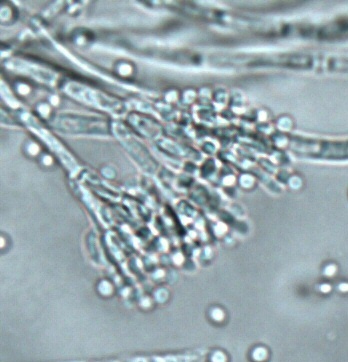Mold Library
Penicillium

Distribution
Like Aspergillus, Penicillium has a worldwide distribution. However, while Aspergillus species tend to frequent warmer tropical regions, Penicillium have the greatest proportion of their species growing in temperate areas. Penicillium species are most commonly found in soils, cellulose materials (plants, wood, paper, etc.), foods, grains, and compost piles. Indoors, Penicillium can be associated with carpet, wallpaper, organic substances, and is also known to grow within fiberglass duct insulation.
Growth Characteristics
The genus Penicillium (in general) has a rapid growth rate. Colonies are usually green, blue-green, or grey green, but can be white, yellow or pinkish. Colonies are mostly velvety to powdery in texture.
Microscopic Characteristics
Microscopically Penicillium species are identified by their dense broom-like spore-bearing structures (penicillin is Latin for little brush), which are known as phialides. Conidiophores can be simple or branched. Phialides are flask shaped and produce chains of spores (conidia) from their tips. The spores are typically green in color, vary in shape but are often globose, with smooth to roughened walls. Identification of Penicillium species is primarily based on the branching habit the species exhibits. Species identifications of Penicillia are difficult as the genus contains over 300 species.
Health Effects
Penicillium species can cause allergic and asthmatic reaction in susceptible individuals. Penicillium is normally nonpathogenic with some exceptions. One example, Penicillium marneffei, a dimorphic species (both filamentous and yeast-like phases), is capable of causing infection of the lymphatic system (lungs, liver, skin, spleen, and bones. P. marneffei can enter through the skin, inhalation, and all points of the digestion tract. Most common regions where infections occur are in Southeast Asia and Indonesia.
The genus Penicillium has may species which produce mycotoxins. These mycotoxins include ochratoxin A (nephrotoxic, hepatotoxic, carcinogenic), penicillin (antibiotic), renitren A and roquefortine C (tremorgenic), patulin (nephrotoxic, carcinogenic), citrinin (carcinogenic), and griseofulvin (tumorigenic, teratogenic, hepatoxic).
